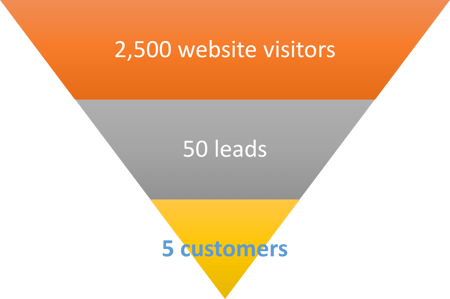
Is your inbound marketing program delivering the results you need? This is the question in many executive's minds as they develop growth plans for the upcoming year. Regardless of what your results are, there is always room for improvement. But how do you know which elements of your inbound marketing need improvement? Because inbound marketing results and techniques are measurable, there is a road map for improvement in your marketing analytics. You just need to decode the analytics to develop a game plan for success.
Read on to see how you can diagnose your inbound marketing plan to determine the steps you need to take to drive better business results.
Diagnose your inbound marketing sales funnel
Inbound marketing analytics can, and should, get really granular. But as an executive diagnosing your inbound marketing results, you need to start with the big picture - your inbound marketing sales funnel. There are three elements to your inbound marketing sales funnel: website visitors, leads and customers. Consider the following scenario:
A buyer finds a blog post on your website via a search engine query. They read the post, check out your homepage and go back to your blog to read another post. At this point, they are a website visitor.
When they go back to your blog, they see a call-to-action promoting an eBook that takes a deeper dive into the subject matter covered in the blog post. They click on the CTA and complete a form on a landing page in exchange for the eBook. They are now a lead.
Over the course of time, they come back to your website and eventually progress to talking to your sales team. The sales team closes the deal and the lead converts to become a customer.
These are high-level analytics, but they are the right analytics for an executive to consider to improve results.
Know your conversion rates
There are two more metrics you need to know to begin your diagnosis - your conversion rates. Conversion rates measure how effective you are at converting website visitors to leads and leads to customers. Here are the formulas to calculate your conversion rates:
Lead conversion rate = Total leads generated / Total website visitors
Customer conversion rate = Total customers / Total leads generated
For example, let's assume you had 2,500 website visitors in October and you generated 18 leads. Your lead conversion ratio is 0.7% (18/2,500.)
Develop a target inbound marketing sales funnel
Now you're ready to diagnose your inbound marketing. The process is to compare your actual results with the results necessary to achieve your revenue goals.
For example, let's assume that you need to get 5 new customers from inbound marketing to hit your revenue goals in January. How many leads do you need to generate to get those 5 customers? Inbound marketing software company HubSpot's data shows that the median customer conversion ratio across their thousands of customers is 7.1% and the top 25% of their customers do 56% or better.
Based on this company's industry and past performance, they set a goal conversion rate of 10%. With a customer conversion rate of 10%, the business needs to generate 50 leads in January to hit their goal of 5 new customers from inbound marketing.
We continue to work our way up the sales funnel by asking the question how many website visitors do we need to generate 50 leads? The HubSpot data shows a median lead conversion ratio of 0.93% and the top 25% of customers hit 3.1% or better.
The business again looks at their industry and past performance and sets a goal lead conversion rate of 2%. With a lead conversion rate of 2%, the business needs to attract 25,000 website visitors in January to hit their goal of 50 leads.
Target Inbound Marketing Sales Funnel

Diagnose your inbound marketing
The diagnosis comes by comparing your actual results with your target sales funnel and determining which part(s) of the funnel need improvement. There are 3 areas where you could be following short - you may have problems in one or you may have multiple problems. Let's look at 3 scenarios based on the target inbound marketing sales funnel we defined above.
Diagnosis I - Not enough website traffic
Consider the following set of results versus targets.
| Actual Results | Target Results | |
| Website visits | 1,500 | 2,500 |
| Leads | 30 | 50 |
| Lead Conversion Ratio | 2.0% | 2.0% |
| Customers | 3 | 5 |
| Customer Conversion Ratio | 10% | 10% |
This business isn't generating enough website traffic to hit their revenue growth targets. The conversion rates for the traffic they're generating are pretty good, but they need to keep the conversion rates at the same levels.
Prescription
This business should focus their inbound marketing on tactics that will get more traffic to their website. Some of the things they might consider are:
-
Working on developing keyword phrases that their buyers use to get information and improving their on-page SEO so that they get more organic website traffic.
-
Blogging more frequently using their targeted keyword phrases in the blog titles.
-
Using social media more effectively to promote their blog and their brand.
Diagnosis 2 - Not enough leads
Here's what this might look like in a comparison.
| Actual Results | Target Results | |
| Website visits | 2,500 | 2,500 |
| Leads | 30 | 50 |
| Lead Conversion Ratio | 1.2% | 2.0% |
| Customers | 3 | 5 |
| Customer Conversion Ratio | 10% | 10% |
This business is generating the website traffic they need to hit their goals, but isn't doing a good enough job on lead conversion to hit revenue growth goals.
Prescription
This business should focus their inbound marketing on tactics that will generate more leads. Some of the things they might consider are:
-
Creating more lead-generation content offers that appeal to their target market.
-
Creating effective calls-to-action for lead-generation content offers and placing them on strategic, high-traffic pages on their website.
Diagnosis 3 - Not enough customers
All of the scenarios result in not enough customer, but in this scenario, the business is generating the necessary website traffic and leads, but still not getting enough customers.
| Actual Results | Target Results | |
| Website visits | 2,500 | 2,500 |
| Leads | 50 | 50 |
| Lead Conversion Ratio | 2.0% | 2.0% |
| Customers | 3 | 5 |
| Customer Conversion Ratio | 6% | 10% |
Prescription
This business needs to tighten up their customer conversion. Some of the things they might consider are:
- Doing a better job with email marketing and lead nurturing.
- Make sure the sales team is getting the right lead intelligence to frame relevant conversations with prospective buyers.
- Reviewing CRM practices and usage.
- Optimizing the sales process to match with the target market buying process.
While the illustrations above are somewhat simplified, we hope this blog post has given you a framework to diagnose your inbound marketing process for improvement in doing what it's designed to do - generate customers. If you'd like to learn more about how you can diagnose your inbound marketing or if you'd like some suggestions on how you can improve, schedule a free consultation with us.







